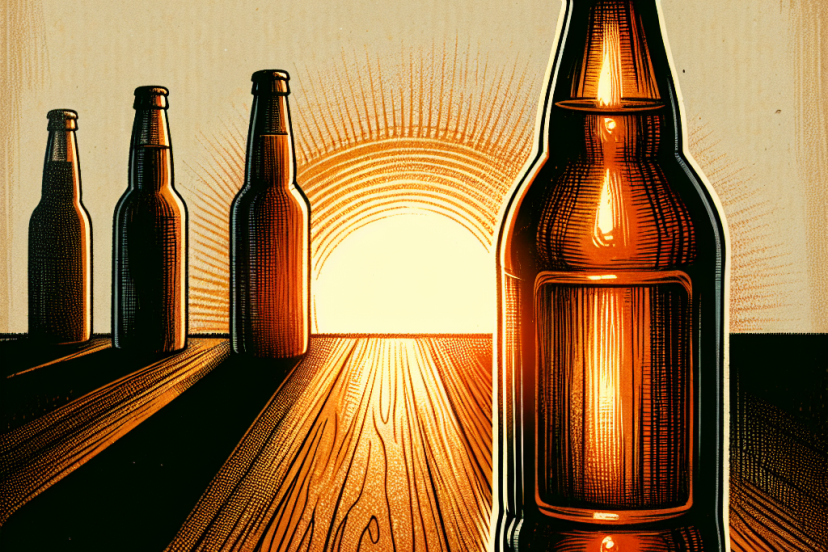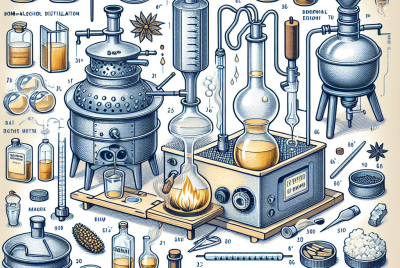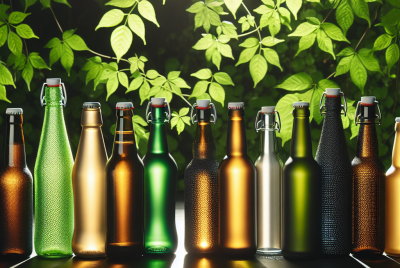The Charm of Stubby Beer Bottles
Picture yourself sitting at a cozy pub, an ice-cold beer in hand. As you take a sip, you can’t help but admire the unique charm of the stubby beer bottle. With its stout and sturdy shape, it evokes a sense of nostalgia that takes you back to a simpler time. These compact vessels hold not only your favorite brew but also a piece of brewing history. In this article, we explore the allure of stubby beer bottles and uncover why they continue to captivate beer enthusiasts around the world. So sit back, relax, and raise a glass to the delightful charm of these iconic bottles.

The History of Stubby Beer Bottles
Stubby beer bottles have a rich and fascinating history that dates back to their origins in the early 20th century. These distinctively short and stout bottles quickly gained popularity and were a common sight in bars and breweries across the globe. However, their popularity eventually declined, only to witness a remarkable resurgence in recent years. Let’s delve into the intriguing history of stubby beer bottles and explore their distinctive features, benefits, nostalgic appeal, global popularity, environmental impact, marketing opportunities, challenges faced, success stories, and future outlook.
Origins of Stubby Bottles
The story of stubby beer bottles begins in the early 20th century when breweries sought to create a more practical and efficient alternative to the traditional long-neck bottles. The shorter design was not only easier to handle and stack but also reduced the risk of breakage during transportation. It is believed that the term “stub” was coined due to the bottle’s resemblance to a short, stubby object.
Popularity in the Early 20th Century
During the early 1900s, stubby beer bottles experienced a surge in popularity and became the preferred choice for many breweries around the world. The short and stout design quickly became an iconic symbol of the beer-drinking culture during that era. With their compact shape, these bottles were easier to grip and fit snugly in the hand, providing a satisfying drinking experience.
Decline and Resurgence
Despite their initial success, stubby beer bottles faced a decline in popularity during the latter half of the 20th century. This decline can be attributed to the rise of new bottle designs and materials, as well as changing consumer preferences. However, in recent years, there has been a notable resurgence of interest in stubby bottles, fueled by nostalgia, a desire for unique packaging options, and an appreciation for their distinct aesthetic.
Distinctive Features of Stubby Beer Bottles
Stubby beer bottles are characterized by their short and stout design, which sets them apart from other bottle types. The compact shape not only makes them easier to grip but also reduces the risk of tipping over. Additionally, stubby bottles are made from thick and durable glass, ensuring their longevity and resistance to breakage. This robust construction allows the bottles to withstand the rigors of transportation and handling, making them a reliable choice for breweries.
Thick and Durable Glass
One of the standout features of stubby beer bottles is their use of thick and durable glass. Unlike thinner glass used in other bottle designs, stubby bottles are better equipped to withstand the pressures of carbonation and rough handling. This ensures that the beer remains fresh and undisturbed throughout its shelf life.
Embossed Logos and Labels
Another distinctive feature of stubby beer bottles is the use of embossed logos and labels. Unlike printed labels that can wear off or fade over time, embossed designs remain intact and retain their visual appeal even after extended use. This attention to detail adds a touch of craftsmanship and nostalgia to these bottles, making them highly sought after by collectors and beer enthusiasts.
Benefits of Stubby Beer Bottles
In addition to their distinctive features, stubby beer bottles offer several benefits that contribute to their enduring appeal among consumers and breweries alike. These benefits include improved ergonomics, enhanced aesthetics, and an extended shelf life for the beer.
Better Ergonomics
Stubby beer bottles boast better ergonomics compared to their longer counterparts. The shorter and wider design fits comfortably in the hand and provides a firm grip, allowing for an enjoyable drinking experience. This ease of handling makes stubby bottles a favored choice among consumers, especially those seeking a more practical and user-friendly option.
Enhanced Aesthetics
Another advantage of stubby beer bottles lies in their enhanced aesthetics. The unique shape and stout appearance of these bottles command attention and convey a sense of vintage charm. Breweries have recognized the visual impact of stubby bottles and often choose them to create a strong brand identity and stand out in a crowded market.
Improved Shelf Life
Stubby beer bottles have been found to enhance the shelf life of the beer they contain. The thick glass and robust construction provide a higher degree of insulation, protecting the beer from temperature fluctuations and external elements. This extended shelf life ensures that consumers can enjoy their favorite brew in optimum condition, without compromising on taste or quality.
The Nostalgic Appeal of Stubby Beer Bottles
Stubby beer bottles hold a special place in the hearts of beer enthusiasts due to their nostalgic appeal. With their iconic design and deep cultural significance, these bottles evoke fond memories of a bygone era and connect people to the rich history of brewing.
Iconic Cultural Significance
Stubby beer bottles have become iconic symbols of the beer-drinking culture, particularly in regions where they enjoyed immense popularity during the early 20th century. Their distinctive appearance and widespread use in bars, pubs, and breweries have made them synonymous with shared memories and milestones among friends and communities.
Connection to Brewery History
Stubby beer bottles can trace their roots back to the early days of brewing, serving as a tangible link to the history and traditions of breweries. By embracing stubby bottles, modern breweries can pay homage to their predecessors and honor the craftsmanship and dedication that went into producing beer in the past.
Collectible Value
The nostalgic appeal of stubby beer bottles extends to their value as collector’s items. Many beer connoisseurs and enthusiasts actively seek out vintage stubby bottles to add to their collections. The limited availability and unique designs make these bottles highly prized among collectors, contributing to their enduring appeal.
Global Popularity of Stubby Beer Bottles
Although stubby beer bottles have their origins in certain regions, their popularity has expanded globally, with enthusiasts and breweries across continents embracing their charm and functionality. In Australia for example, almost all bought beer comes in stubby bottles, and bottled beer is often referred to as a stubby.
European Love for Stubby Bottles
Stubby beer bottles have been particularly beloved in European beer-drinking cultures. Countries such as Germany, Belgium, and the UK have a strong tradition of using stubby bottles, which have been a part of their beer heritage for decades. This European love for stubby bottles exemplifies their enduring appeal and the cultural significance attached to them.
North American Market
In North America, stubby beer bottles have seen a resurgence in recent years, fueled by a renewed interest in craft beer and unique packaging options. Many breweries in the United States and Canada have adopted stubby bottles as a way to differentiate themselves in a competitive market and evoke a sense of nostalgia among consumers.

Asian Influence
Stubby beer bottles have also gained popularity in Asia, where they have been embraced as a symbol of craftsmanship and quality. The rise of the craft beer scene in countries like Japan and South Korea has contributed to the increased demand for stubby bottles, as consumers seek a unique and visually appealing drinking experience.
Environmental Impact of Stubby Beer Bottles
In addition to their aesthetic, cultural, and historical significance, stubby beer bottles offer several environmental advantages compared to other beer packaging options.
Reduced Carbon Footprint
Stubby beer bottles contribute to a reduced carbon footprint due to their compact size and efficient use of materials. Their shorter design allows more bottles to be transported in one shipment, reducing the number of trips required and the overall carbon emissions associated with transportation.
Sustainable Packaging Options
Stubby beer bottles can be made from sustainable materials such as recycled glass or be designed for easy recycling and reuse. This commitment to sustainability aligns with the growing consumer demand for eco-friendly packaging options and allows breweries to make a positive environmental impact.
Recycling and Reusability
Stubby beer bottles are widely accepted by recycling programs, making it easy for consumers to do their part in promoting a circular economy. Additionally, the durable nature of stubby bottles enables them to be reused, further reducing waste and conserving resources.
Differentiation in a Saturated Market
With the craft beer industry experiencing rapid growth, breweries are constantly seeking ways to stand out from the crowd. Adopting stubby beer bottles provides a distinct packaging option that captures the attention of consumers, distinguishing the brand from competitors and creating a memorable experience.
Customization and Design
Stubby beer bottles offer ample space for breweries to showcase their creativity and brand identity. The compact shape serves as a canvas for unique label designs, embossed logos, and customized packaging options, allowing breweries to tell their story and connect with consumers on a deeper level.
Increased Consumer Engagement
The charm and nostalgia associated with stubby beer bottles often lead to increased consumer engagement. These bottles spark conversations, generate buzz on social media, and create a sense of connection between the brand and its customers. Breweries can leverage this engagement to build a loyal customer base and drive sales.
Logistical Concerns
The short and stout design of stubby beer bottles can present logistical concerns for breweries. Bottling lines and equipment may need to be adjusted to accommodate the compact shape, potentially increasing costs and production challenges. However, with proper planning and investment in infrastructure, these concerns can be overcome.
Perception and Consumer Demand
The perception of stubby beer bottles as being associated with a specific era or style of beer can impact their demand. While some consumers value the nostalgic appeal, others may view stubby bottles as outdated or less sophisticated. To overcome this perception, breweries can emphasize the modern touches and innovations they bring to the traditional design, highlighting the best of both worlds.
Success Stories of Breweries with Stubby Beer Bottles
Despite the challenges, several breweries have successfully embraced stubby beer bottles, leading to increased sales, market share, and positive customer feedback.
Craft Breweries Embracing Stubby Bottles
Craft breweries, in particular, have found success by adopting stubby beer bottles. These smaller-scale breweries prioritize craftsmanship, unique flavors, and premium experiences, making stubby bottles a perfect fit for their brand identity. The distinctiveness of stubby bottles helps these breweries differentiate themselves from mass-produced beers and attract a loyal customer base.
Increased Sales and Market Share
Breweries that have embraced stubby beer bottles have witnessed increased sales and market share. The visually appealing design, combined with the unique drinking experience, resonates with consumers, leading to greater brand recognition and loyalty. Additionally, the collectible value of stubby bottles encourages repeat purchases and drives customer engagement.
Positive Customer Feedback
Breweries that have introduced stubby beer bottles often receive positive feedback from customers. Consumers appreciate the nostalgic appeal, improved ergonomics, and enhanced aesthetics offered by stubby bottles. This positive reception further bolsters the market demand for stubby bottles and encourages breweries to continue their use.
Future Outlook for Stubby Beer Bottles
Looking ahead, the future appears bright for stubby beer bottles as they continue to witness growth, innovation, and regulatory support.
Continued Growth and Innovation
With the resurgence of interest in stubby beer bottles, breweries are likely to continue adopting this unique packaging option. This trend is fueled by consumer demand for visually appealing and authentic experiences, as well as breweries’ desire to differentiate themselves in an increasingly competitive market. As a result, we can expect to see further growth and innovation in the stubby bottle industry.
Adapting to Evolving Market Trends
Stubby beer bottles have proven their ability to adapt to evolving market trends, and this adaptability will be crucial for their future success. As consumer preferences and expectations change, breweries will need to continue innovating and finding new ways to leverage the charm and benefits of stubby bottles to meet evolving market demands. By staying attuned to consumer needs, breweries can ensure that stubby beer bottles remain a beloved choice for beer enthusiasts for years to come.
In conclusion, the history of stubby beer bottles is filled with rich traditions, distinctive features, and a strong connection to the beer-drinking culture. Despite facing challenges and a decline in popularity, stubby bottles have experienced a remarkable resurgence, capturing the hearts of beer lovers and breweries worldwide. With their ergonomic design, enhanced aesthetics, and environmental advantages, stubby beer bottles offer a unique and meaningful drinking experience. As they continue to evolve and adapt to market trends, stubby bottles are poised to play a significant role in shaping the future of the beer industry.




